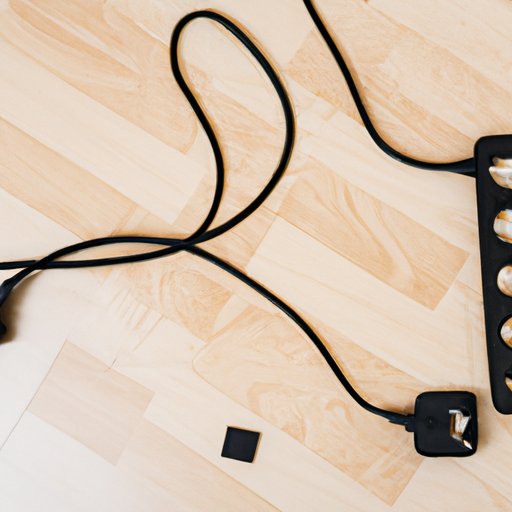Introduction
If you’ve ever plugged in an appliance and suddenly found yourself in the dark because the outlet tripped, you’re not alone. Tripping outlets are a common electrical issue that can be frustrating and potentially dangerous if left unresolved. In this article, we’ll explain why outlets trip, how to troubleshoot and resolve the issue, and what can happen if it’s not addressed.
Understanding Why Outlets Trip
When an outlet trips, it’s essentially a safety mechanism that shuts off power when it detects an electrical problem. The three main causes of tripping outlets are overloading, short circuits, and ground faults. Overloading occurs when too many high-wattage appliances are plugged into a circuit. Short circuits happen when an electrical current follows an unintended path, often due to damaged wiring or faulty appliances. Ground faults happen when an electrical current follows a path through the ground instead of the circuit, which can lead to electric shock or other hazards.
Some common appliances that can cause overloading and tripping outlets include hair dryers, space heaters, and vacuum cleaners. However, faulty wiring or outdated electrical panels can also contribute to tripping outlets, so it’s important to consider the overall state of your home’s electrical system if you’re experiencing frequent outages.
Common Causes and Solutions
Let’s explore some common reasons for tripping outlets and how to address them. If you’re consistently overloading a circuit, try unplugging high-wattage appliances when not in use, spreading them across different circuits, or using a surge protector. If you suspect a faulty appliance is causing the issue, inspect the appliance for any worn or damaged cords or switches, and consider replacing it if necessary. Finally, if you suspect outdated wiring or an electrical panel is behind the issue, contact a licensed electrician to evaluate the situation and recommend the appropriate upgrades.
What Happens When Outlets Trip
There are some common misconceptions about the potential dangers of tripping outlets. While it may seem like tripping outlets are always a sign of imminent danger, this is not always the case. In fact, circuit breakers are designed to prevent electrical fires by cutting power when they detect a problem. Different types of circuit breakers have different thresholds for tripping, so it’s important to understand the specific system in your home and its capabilities.
However, if tripping outlets are left unaddressed, there can be consequences. Electrical fires can potentially occur if a circuit is overloaded and power is not cut off in time. Additionally, tripping outlets can damage appliances and electronics over time, leading to expensive repair or replacement costs.
Troubleshooting and Resolving Tripping Outlets
Here are some step-by-step instructions for troubleshooting and resolving tripping outlets:
- Unplug all appliances and electronics from the outlet.
- Reset the circuit breaker by flipping the switch to the off position, then back on.
- Plug in the appliances one at a time and observe if the circuit breaker trips again. If it does, the problem may be the appliance and not the circuit.
- If the appliance is faulty, try replacing any worn cords or switches, or replacing the appliance entirely.
- If the issue persists, seek professional help from a licensed electrician.
It’s important to note that electrical work can be dangerous, so always turn off power and take appropriate safety precautions before attempting any repairs. If you’re unsure about the issue or how to resolve it safely, don’t hesitate to seek professional help.
Causes and Methods of Solving Tripping Outlets
Now that we’ve covered some basic troubleshooting tips, let’s dive deeper into the different causes behind tripping outlets and possible solutions for each type of issue. Overloading can sometimes be solved by upgrading to a higher-wattage circuit, or by spreading out high-wattage appliances across different circuits. Short circuits often require professional repair or replacement of damaged wiring or appliances. Ground faults can be prevented by using Ground Fault Circuit Interrupter (GFCI) outlets, which will shut off power quickly in the event of a ground fault.
Identifying and Repairing Tripping Outlets
Here are some additional tips for identifying and repairing tripping outlets:
- Check for loose connections or broken wiring at the outlet
- Use a multimeter to test the circuit’s voltage and continuity
- Consider upgrading to AFCI (Arc Fault Circuit Interrupter) breakers, which can detect and respond to a broader range of electrical issues
Addressing tripping outlets promptly is crucial to preventing further damage to your home’s electrical system or potential safety hazards. If you’re unsure of how to diagnose or repair the issue, it’s always best to seek professional help to ensure the job is done safely and effectively.
Conclusion
In conclusion, tripping outlets can be a frustrating and potentially dangerous electrical issue, but with a bit of knowledge and troubleshooting, they can be resolved safely and effectively. Remember to take appropriate safety precautions when attempting any electrical repairs, and seek professional help if you’re unsure about the issue or how to resolve it. By keeping your home’s electrical system in good shape, you’ll ensure a safe and reliable supply of power for years to come.
(Note: Is this article not meeting your expectations? Do you have knowledge or insights to share? Unlock new opportunities and expand your reach by joining our authors team. Click Registration to join us and share your expertise with our readers.)
